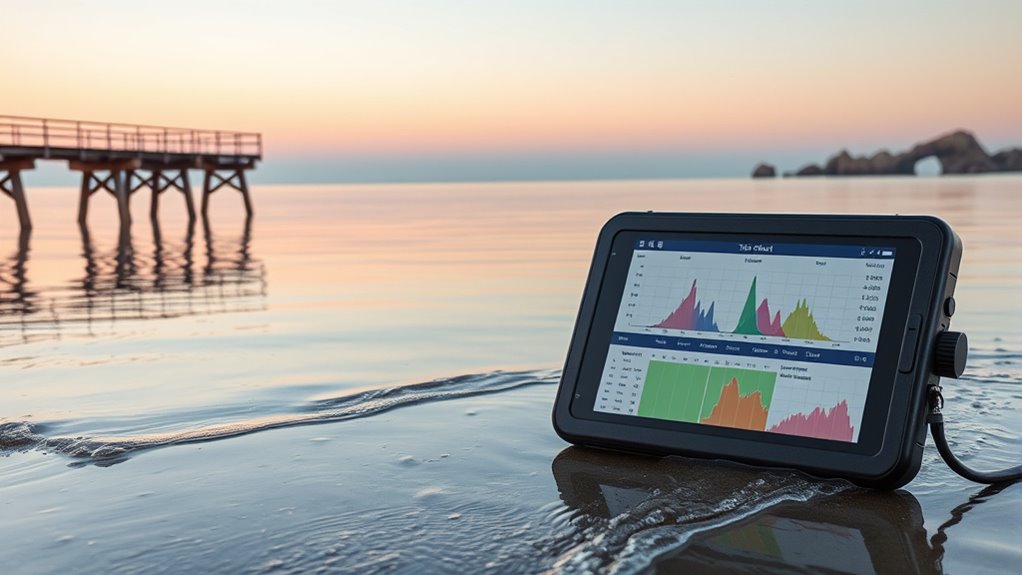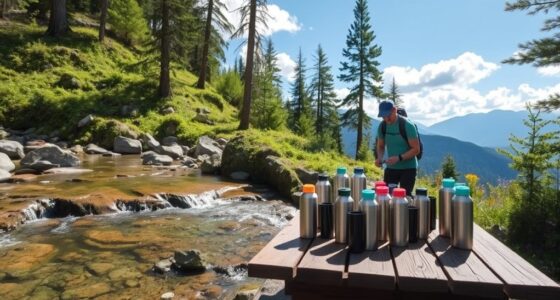Mastering tide tables is easier than you might think. These charts predict water levels by relying on the moon’s and sun’s predictable gravitational pull, and they display times and heights of high and low tides for specific locations. By knowing how to interpret the symbols and data, you can plan water activities safely and efficiently. Keep exploring, and you’ll discover how simple forecasting your local tides can become with a little practice.
Key Takeaways
- Understand the basic structure of tide tables, including date, time, and tide height indicators.
- Recognize that tide predictions are based on lunar and solar gravitational cycles.
- Learn to identify high and low tide times and their significance for planning activities.
- Use online tools or mobile apps for real-time tide updates and location-specific forecasts.
- Consider local factors like coastline shape and weather for more accurate tide forecasting.

Ever wonder how sailors and fishermen know when the tide will be high or low? It’s all about understanding tide tables, which are essential tools in marine navigation and coastal ecology. These tables provide precise information about the timing and height of tides, helping you plan your activities on the water or along the shoreline. When you master how to read tide tables, you gain a vital advantage in ensuring safety, efficiency, and harmony with the environment.
Tide tables are based on predictable astronomical patterns, mainly the gravitational pull of the moon and the sun. Because these forces influence the rise and fall of ocean waters, tide tables use complex calculations to forecast tide times and levels days or even weeks in advance. You don’t need to be a scientist to understand them; once you get familiar with the symbols and data, you’ll see how straightforward they are. Most tide tables list the date, time, and height of high and low tides, allowing you to plan your boat trips, fishing expeditions, or beach visits accordingly.
Tide tables use astronomical patterns to predict tide times and heights days or weeks ahead.
In marine navigation, knowing when tides will be high or low is essential. Tides determine whether certain channels or harbors are accessible, especially in shallow waters where ships risk running aground during low tide. By consulting tide tables regularly, you can avoid dangerous situations and optimize your routes. This foresight is especially important in coastal ecology, where the timing of tides influences wildlife behavior and habitats. For example, many coastal species depend on tidal cycles for feeding, breeding, or migration. If you understand tide patterns, you can better appreciate and protect these delicate ecosystems.
Using tide tables is simple once you know what to look for. First, identify your location since tide times vary along different coastlines. Next, check the date you’re interested in, then find the corresponding high and low tide times and their heights. Many online resources and mobile apps make this process even easier, providing real-time updates and alerts. Keep in mind that local factors like coastline shape and weather can cause slight variations, so it’s wise to double-check with local tide stations or harbor masters if you’re planning critical activities.
Frequently Asked Questions
How Accurate Are Tide Tables for Long-Term Planning?
Tide tables are fairly accurate for short-term planning, but their long-term accuracy can vary due to tide variability and changes in coastal conditions. You rely on historical data to predict tides, but natural fluctuations and climate influences can cause deviations. For precise long-term planning, consider combining tide tables with real-time data and local insights to account for these variations and improve your outcomes.
Can Weather Conditions Affect Tide Predictions?
Weather patterns and atmospheric pressure are like unpredictable artists, painting the tides in unexpected ways. They can influence tide predictions by causing deviations from expected levels. Sudden storms, high winds, or shifts in atmospheric pressure can lead to discrepancies between forecasted and actual tides. So, while tide tables provide a reliable framework, always stay alert to changing weather conditions for the most accurate planning.
Are There Digital Tools That Update Tide Tables Automatically?
You’ll find many digital apps that offer automatic updates for tide tables, making planning easier. These apps pull real-time data from weather and ocean conditions, ensuring you get accurate tide info without manual adjustments. With these tools, you won’t have to worry about outdated forecasts, especially when weather changes unexpectedly. Just download a trusted tide app, and enjoy reliable, automatic updates for your boating, fishing, or beach activities.
How Do Lunar Phases Influence Tide Levels?
Imagine the moon as a gentle artist, shaping the ocean’s canvas with lunar cycles. These cycles influence tidal amplitudes, causing high and low tides to rise and fall. When the moon is full or new, tides become more pronounced, like a crescendo in a symphony. As the moon wanes, tides soften. Understanding this celestial dance helps you predict how lunar phases will impact tide levels.
What Should I Do if Tide Tables Are Unavailable?
If tide tables are unavailable, you should look for alternative sources like local marinas, weather apps, or online tide charts. You can also attempt manual calculation using lunar phases, moonrise and moonset times, and historical tide data for your area. Keep in mind, this method isn’t perfect, but it can help you estimate tide levels until you access official tables again.
Conclusion
By mastering tide tables, you’ve unlocked a secret to steering the ocean’s rhythm with confidence. Think of it like riding a wave — once you understand its pattern, you’re more likely to catch a smooth ride rather than wipe out. I remember planning a fishing trip, checking the tide, and timing my arrival perfectly. That day, everything lined up — a reminder that understanding tides transforms unpredictability into opportunity. Now, you’re ready to surf those tides with ease!










